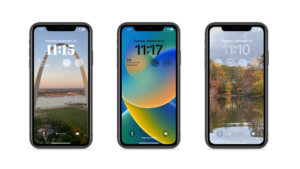Apple has been busy lately, and while a lot of attention has been paid to new, updated iPhone models, you can’t overlook the latest iOS update (iOS 16) and the impact it will have on users’ mobile experience expectations. What may appear, superficially, to be an update to provide deeper personalization of an already deeply personal device, belies an underlying shift in the way we approach the utility of our devices and will raise the bar significantly for user expectations across the entire mobile app ecosystem. Businesses in the mobile space who are quick to embrace these new features and capabilities will be the ones who benefit most from the coming shift, and it all begins on the lock-screen.

The Most Valuable Real Estate in Mobile
In the past, the lock-screen was nothing more than a security barrier. It prevented unauthorized users from accessing apps and information, and the utility of the lock-screen extend to a clock and not much else. Over time as the lock-screen evolved, users embraced quick access to the camera and the flashlight, but for years, the lock-screen served primarily as the locked (or unlocked) gateway to your mobile experience.
When iOS 14 was released, it introduced widgets into the lexicon, but limited their utility to the home screen. Now, with the release of iOS 16, Apple has taken the utility and functional value of the widget and moved it to the lock-screen, opening up an entirely new way of interacting with their most valued apps and placing it front and center on what’s turning out to be the most valuable real estate in mobile. Users now have two widget areas on their lock-screens that they can customize by selecting from a library of widgets from mobile apps that have been updated to support this new capability.
Already, fitness apps, productivity, and others are racing to provide users with the ability to see important information or updates without having to even open their app. In the fall, Apple will further expand this opportunity with Live Activities that will update users in real-time, allowing users to see live information at-a-glance. The key takeaway is that the lock-screen is quickly becoming a useful and valuable aspect of the mobile experience, and businesses cannot ignore this evolution of value and utility that no longer relies on having a stand-alone mobile app. As this experience rapidly becomes ubiquitous, the bar will be raised for everyone to take a good look at both the utility and information their app can provide to users quickly, and the friction inherent in getting there.
iOS 16 Evolves User Expectations
There are a lot of great new features in Apple’s latest operating system update. New health and fitness-related updates are making it easy for users to track medications, receive reminders, and log fitness activities. The messaging experience continues to evolve as well, including expanded sharing capabilities. Crash detection, utilizing the on-device hardware capabilities coupled with Machine Learning to detect if you’ve been in a car crash has potentially life-saving implications.
It’s the continued evolution of capabilities moving “beyond the app” that is going to have long-lasting impact for users and raise the bar for what’s considered friction in a mobile experience. Giving users access to that core functionality or capability on the lock-screen without having to even open an app, much less navigate to it, open it, and get to that experience will very quickly become a user expectation, and businesses that aren’t recognizing this shift and embracing it will find themselves on the outside looking in.
Expertise Across the Mobile Landscape
Perficient’s Mobile Solutions team specializes in mobile application and product development. We help our clients leverage the latest technology to deliver top-rated mobile applications.
For more information about Perficient’s Mobile Solutions expertise, subscribe to our blog or contact our Mobile Solutions team today!
